 Teamwork makes the dream work.
Teamwork makes the dream work.
At least, that could be the new Salesforce mantra for a suite of cross-cloud integrations and partnerships launched this week as Salesforce tries to separate itself from other leading marketing cloud companies.
With so much competition and jargon in the cloud marketing technology space, it can be hard to differentiate, said Jon Suarez-Davis, the Salesforce Marketing Cloud strategy chief.
But what separates Salesforce, he said, is its stronger integration technology – boosted by the $6.5 billion acquisition of middleware technology company MuleSoft in March – and stronger partnerships it can offer, in part, because Salesforce doesn’t supply paid media tech.
Take Salesforce Marketing Cloud’s API integration with Google Analytics (GA) 360, which officially launched Wednesday and marks the first time GA campaign reporting has been piped directly to another dashboard and that audience lists created in GA could be exported to another platform for marketing.
While other marketing clouds develop their own attribution and media measurement products, “we see our value in being able to integrate with other attribution providers and make them better,” Suarez-Davis said.
The GA partnership is also only possible because Salesforce doesn’t venture directly into advertising. The Google audience lists exported from the platform, for instance, can be used for email or mobile messaging but not for paid media.
Other cloud leaders have signaled their interest in paid media, like Adobe taking over the TubeMogul DSP and Oracle’s acquisition with Grapeshot and Moat, while Salesforce has bet big on integration technology like MuleSoft, Suarez-Davis said.
Salesforce is also collaborating more within its own cloud platforms. At the Salesforce Connections conference in Chicago on Thursday, the company launched Commerce Journeys, a joint product of the Marketing and Commerce clouds, and an integration between the Commerce Cloud and Service Cloud.
Suarez-Davis said connecting the cloud offerings helps Salesforce secure market share and meet new market demands.
For Ticketmaster, a customer of Salesforce’s marketing, sales and service clouds, it’s critical to be able to step seamlessly between the three suites as mobile engagement collapses the walls between those parts of the organization, said Kat Frederick, executive VP of growth and insights.
Knowing the right way to engage someone who is considering tickets or that same person checking Ticketmaster at the venue after they already purchased a ticket is critical for how the company would respond – and whether the response would be “owned” by marketing, customer service or sales.
Previously, mobile was used to batch and blast messages based on recent actions (buy a ticket, get an email; go to a show, get a message), Frederick said. Now mobile is about stringing together the customer journey to identify the right time and tone to engage someone without being tied directly to transactions, she said.
Hickory Farms, the food and gift company, implemented the Salesforce Marketing Cloud last year after being a longtime customer of the Commerce Cloud, and the combination has helped reshape its email strategy from essentially being for receipt confirmation and marketing blasts during the holidays to “a true decision-tree model to understand customer decisions,” said CMO Judy Ransford.
As Hickory Farms builds out categories like meat and sweets, the commerce and marketing cloud mix helps bridge site and sales data into in a longer view of individual customer journeys, she said. So, for example, people who bought a steak gift for Father’s Day or candy on Valentine’s Day may call for different holiday messaging in December.
Working with two Salesforce cloud groups has also allowed Hickory Farms to trim its vendor roster from point solutions to a single, more consultative partner. “We want the vendor model to be more part of the team, rather than an outsourced ‘throw it over the fence and get it back’ kind of partner,” Ransford said.
This post was syndicated from Ad Exchanger.

More Stories
The Latest CMA Report Brings New Privacy Concerns to Google’s Cookie Deprecation Plans
Comic: The Curated Marketplace
INMA Global Media Awards: NZME wins Best Use of Print